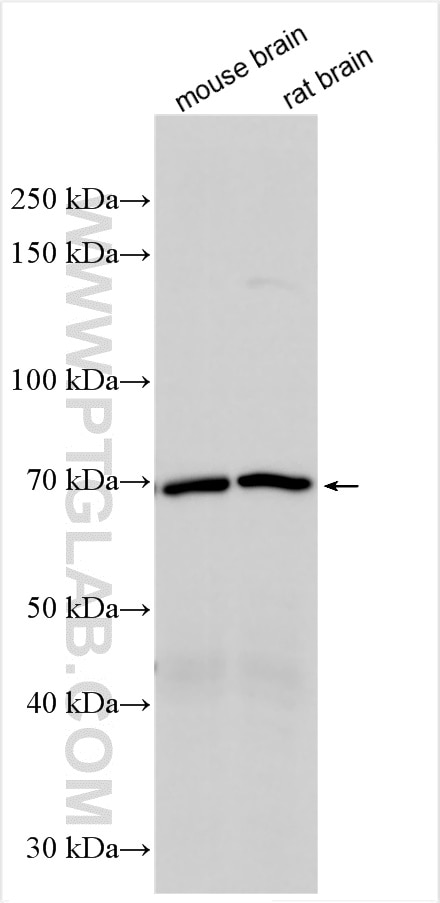Validation Data Gallery
Tested Applications
| Positive WB detected in | mouse brain tissue, rat brain tissue |
Recommended dilution
| Application | Dilution |
|---|---|
| Western Blot (WB) | WB : 1:500-1:1000 |
| It is recommended that this reagent should be titrated in each testing system to obtain optimal results. | |
| Sample-dependent, Check data in validation data gallery. | |
Product Information
27303-1-AP targets VAChT in WB, ELISA applications and shows reactivity with human, mouse, rat samples.
| Tested Reactivity | human, mouse, rat |
| Host / Isotype | Rabbit / IgG |
| Class | Polyclonal |
| Type | Antibody |
| Immunogen | VAChT fusion protein Ag25153 相同性解析による交差性が予測される生物種 |
| Full Name | solute carrier family 18 (vesicular acetylcholine), member 3 |
| Calculated molecular weight | 532 aa, 57 kDa |
| Observed molecular weight | 70 kDa |
| GenBank accession number | BC007765 |
| Gene Symbol | VAChT |
| Gene ID (NCBI) | 6572 |
| RRID | AB_3669592 |
| Conjugate | Unconjugated |
| Form | Liquid |
| Purification Method | Antigen affinity purification |
| UNIPROT ID | Q16572 |
| Storage Buffer | PBS with 0.02% sodium azide and 50% glycerol , pH 7.3 |
| Storage Conditions | Store at -20°C. Stable for one year after shipment. Aliquoting is unnecessary for -20oC storage. |
Background Information
SLC18A3 also known as VAChT, is the vesicular amine transporter family member. The SLC18A3 gene encodes a transmembrane protein that transports acetylcholine (ACh) into presynaptic secretory vesicles for release at cholinergic nerve endings in the central and peripheral nervous systems. Mutations in SLC18A3 are associated with congenital myasthenic syndrome(PMID: 27590285). The 68-70 kDa mature glycosylated form of VAChT can be detected (PMID: 14705140).
Protocols
| Product Specific Protocols | |
|---|---|
| WB protocol for VAChT antibody 27303-1-AP | Download protocol |
| Standard Protocols | |
|---|---|
| Click here to view our Standard Protocols |
